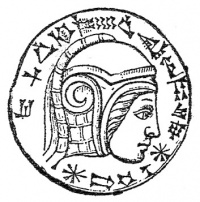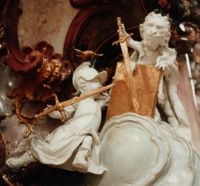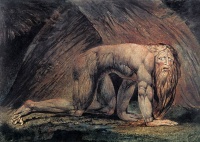Nebuchadnezzar II
From Textus Receptus
Nebuchadnezzar II, also called King Nebuchadnezzar the Second Template:Audio (c 630-562 BC), was a ruler of Babylon in the Chaldean Dynasty, who reigned c. 605 BC-562 BC. He is mentioned in the Book of Daniel, and he constructed the Hanging Gardens of Babylon. He conquered Judah and Jerusalem, and sent the Jews into exile. He was traditionally called "Nebuchadnezzar the Great" (Daniel 1:1; Jeremiah 25:11). In contemporary Iraq and some other parts of the Middle East, he is glorified as a historic leader.
Contents |
Name
The Akkadian name, Nabû-kudurri-uṣur, means "Oh god Nabu, preserve/defend my firstborn son". Nabu is the Babylonian deity of wisdom, and son of the god Marduk. In an inscription, Nebuchadnezzar styles himself as "Nabu's favourite".Template:Fact
The name is often mistakenly interpreted as "O Nabu, defend my kudurru"Template:Fact, in which sense a kudurru is an inscribed stone deed of property. However, when contained in a ruler's title, kudurru approximates to "bad indigestion" or "possible liver problem" <ref> Chicago Assyrian Dictionary sub Kudurru Ca5'</ref>.
The Hebrew form is נְבוּכַדְנֶצַּר (Nəḇūḵaḏneṣṣar or simply Nevuchadnetsar), but is also found as נְבוּכַדְנֶאצַּר and נְבוּכַדְרֶאצַּר (Nəḇuḵaḏreṣṣar). The Greek form was Ναβουχοδονόσωρ. He is also known as Bakhat Nasar, which means "winner of the fate", or literally, "fate winner".
Biography
Nebuchadnezzar II was the eldest son, and successor, of Nabopolassar, who delivered Babylon from its dependence on Assyria and laid Nineveh in ruins. According to Berossus, he married Amytis of Media, the daughter or granddaughter of Cyaxares, king of the Medes, and thus the Median and Babylonian dynasties were united.
Nabopolassar was intent on annexing the western provinces of Syria from Necho II (who was still hoping to restore Assyrian power), and to this end dispatched his son westward with a powerful army. In the ensuing Battle of Carchemish in 605 BC, the Egyptian army was defeated and driven back, and Syria and Phoenicia were brought under the control of Babylon. Nabopolassar died in August of that year, and Nebuchadnezzar returned to Babylon to ascend to the throne.
After the defeat of the Cimmerians and Scythians, all of Nebuchadnezzar's expeditions were directed westwards, although the powerful Median empire lay to the north. Nebuchadnezzar's political marriage to Amuhia, the daughter of the Median king, had ensured peace between the two empires.
Nebuchadnezzar engaged in several military campaigns designed to increase Babylonian influence in Syria and Judah. An attempted invasion of Egypt in 601 BC was met with setbacks, however, leading to numerous rebellions among the states of the Levant, including Judah. Nebuchadnezzar soon dealt with these rebellions, capturing Jerusalem in 597 BC and deposing King Jehoiakim, then in 587 BC due to rebellion, destroying both the city and the temple, and deporting many of the prominent citizens along with a sizable portion of the Jewish population of Judea to Babylon.<ref>Flavius Josephus, Antiquities of the Jews, Book VIII, ch. 6-8</ref> These events are described in the Prophets (Nevi'im) and Writings (Ketuvim), sections of the Hebrew Bible. After the destruction of Jerusalem, Nebuchadnezzar engaged in a thirteen year siege of Tyre (585-572 BC), which ended in a compromise, with the Tyrians accepting Babylonian authority.
Following the pacification of Tyre, Nebuchadnezzar turned again to Egypt. Referring to his wars, a clay tabletTemplate:Which?, now in the British Museum, states: "In the 37th year of Nebuchadnezzar, king of the country of Babylon, he went to Mitzraim (Egypt) to make war. Amasis, king of Egypt, collected [his army], and marched and spread abroad." Having completed the subjugation of Phoenicia, and a campaign against Egypt, Nebuchadnezzar set himself to rebuild and adorn the city of Babylon, and constructed canals, aqueducts, temples and reservoirs.
Babylonian tradition has it that towards the end of his life, Nebuchadnezzar, inspired from on high, prophesied the impending ruin to the Chaldean Empire (Berosus and Abydenus in Eusebius, Praeparatio Evangelica, 9.41). Nebuchadnezzar died in Babylon between the second and sixth months of the forty-third year of his reign.
Construction activity
[[File:Pergamon Museum Berlin 2007085.jpg|thumb|Building Inscription of King Nebukadnezar II at the Ishtar Gate. An abridged excerpt says: "I (Nebuchadnezzar) laid the foundation of the gates down to the ground water level and had them built out of pure blue stone. Upon the walls in the inner room of the gate are bulls and dragons and thus I magnificently adorned them with luxurious splendour for all mankind to behold in awe."]] Nebuchadnezzar seems to have prided himself on his constructions more than on his victories. During the last century of Niniveh's existence, Babylon had been greatly devastated, not only at the hands of Sennacherib and Assurbanipal, but also as a result of her ever renewed rebellions. Nebuchadnezzar, continuing his father's work of reconstruction, aimed at making his capital one of the world's wonders. Old temples were restored; new edifices of incredible magnificence were erected to the many gods of the Babylonian pantheon (Diodorus of Sicily, 2.95; Herodotus, 1.183). To complete the royal palace begun by Nabopolassar, nothing was spared, neither "cedar-wood, nor bronze, gold, silver, rare and precious stones";Template:Fact an underground passage and a stone bridge connected the two parts of the city separated by the Euphrates; the city itself was rendered impregnable by the construction of a triple line of walls. The bridge across the Euphrates is of particular interest, in that it was supported on asphalt covered brick piers that were streamlined to reduce the upstream resistance to flow, and the downstream turbulence that would otherwise undermine the foundations. Nor was Nebuchadnezzar's activity confined to the capital; he is credited with the restoration of the Lake of Sippar, the opening of a port on the Persian Gulf, and the building of the Mede wall between the Tigris and the Euphrates to protect the country against incursions from the North. In fact, there is scarcely a place around Babylon where his name does not appear and where traces of his activity are not found. These gigantic undertakings required an innumerable host of workmen; from the inscription of the great temple of Marduk, we may infer that most probably captives brought from various parts of Western Asia made up a large part of the labouring force used in all his public works.
Nebuchadnezzar is credited with the construction of the hanging gardens, for his wife Amyitis (or Amytis) to remind her of her homeland, Medis (or Media).<ref name="FosterGardensofEden">Template:Cite conference</ref> However, some scholars argue that they may have been constructed by a ruler from Ninevah.<ref>"How the Seven Wonders of the Ancient World Work". Stuff You Missed in History Class. 8.04.08</ref>
Portrayal in the Books of Daniel and Jeremiah
Nebuchadnezzar is most widely known through his portrayal in the Bible, especially the Book of Daniel as נְבוּכַדְנֶאצַּר. This book discusses several events of his reign, in addition to his conquest of Jerusalem.
In the second year of his reign (evidently counting from his conquest of the Jews), Nebuchadnezzar dreams of a huge image made of various materials (gold, silver, bronze, iron, etc). The prophet Daniel tells him God's interpretation, that it stands for the rise and fall of world powers. (Daniel Chapter 2)
During another incident, Nebuchadnezzar erects a large idol for worship during a public ceremony on the plain of Dura. When three Jews, Hananiah, Mishael, and Azariah (respectively renamed Shadrach, Meshach, and Abednego by their captors, to facilitate their assimilation into Babylonian culture), refuse to take part, he has them cast into a fiery furnace. They are protected by God Himself (a theophany) [Daniel 3:25, KJV], and emerge unscathed without even the smell of smoke. (Daniel Chapter 3)
Another dream, this time of an immense tree, is interpreted by Daniel the prophet. (Daniel Chapter 4) Chapter 4 is also written by Nebuchadnezzar (Nebuchadnezzar the king, unto all people, nations, and languages, that dwell in all the earth; Peace be multiplied unto you: I thought it good to shew the signs and wonders that the high god hath wrought me.) Dan. 4:1-2
While boasting over his achievements, Nebuchadnezzar is humbled by God. The king loses his sanity and lives in the wild like an animal for seven years (by some considered as an attack of the madness called clinical boanthropy or alternately porphyria). After this, his sanity and position are restored and he praises and honors God.
A clay tablet in the British Museum (BM34113) describes Nebuchadnezzar's behaviour during his insanity: "His life appeared of no value to him... then he gives an entirely different order... he does not show love to son or daughter... family and clan does not exist."<ref>Kendall K. Down, Daniel: Hostage in Babylon, p.30</ref> There is no record of acts or decrees by the king during 582 to 575 BC.<ref>Gleason Archer, Vol 7 Expositor's Bible Commentary.</ref>
Based upon descriptions of Nebuchadnezzar's actions and physical traits, psychologist Henry Gleitman claims that Nebuchadnezzar's descent into insanity was a result of syphilis infection. Gleitman believes his odd behavior was actually general paresis or paralytic dementia seen in advanced cases of syphilitic infection.<ref>Henry Gleitman, Psychology (New York: W W Norton, 2007), 219.</ref>
Some scholars think that Nebuchadnezzar's portrayal by Daniel is a mixture of traditions about Nebuchadnezzar — he was indeed the one who conquered Jerusalem — and about Nabonidus (Nabuna'id). For example, Nabonidus was the natural, or paternal father of Belshazzar, and the seven years of insanity could be related to Nabonidus' sojourn in Tayma in the desert. Evidence supporting this view was found on some fragments from the Dead Sea Scrolls that reference Nabonidus (N-b-n-y) being smitten by God with a fever for seven years of his reign while his son Belshazzar was regent.
The Book of Jeremiah contains a prophecy about the arising of a "destroyer of nations", commonly regarded as a reference to Nebuchadnezzar (Jer. 4:7), as well as an account of Nebuchadnezzar's siege of Jerusalem and looting and destruction of the temple (Jer. 52).
Named after Nebuchadnezzar
- The Nabucco pipeline is a planned natural gas pipeline that will transport natural gas from Turkey to Austria, via Bulgaria, Romania, and Hungary
- There is a type of daylily named "Nebuchadnezzar's Furnace".
- A bottle of champagne filled with the volume equivalent of 20 standard bottles (15 litres) is called a Nebuchadnezzar.
- In The Matrix film trilogy, the hovercraft captained by Morpheus is named the Nebuchadnezzar.
- The opera Nabucco by Giuseppe Verdi
- Saddam Hussein named one of his Republican Guards divisions after Nebuchadnezzar.
- Saddam Hussein considered himself to be the reincarnation of Nebuchadnezzar<ref>Encyclopedia of the Developing World, Edited by Thomas M. Leonard, p.793.</ref> and had the inscription "To King Nebuchadnezzar in the reign of Saddam Hussein" inscribed onto numerous bricks that were inserted into the walls of the ancient city of Babylon during a reconstruction project that he initiated.<ref>Archeology Under Dictatorship, Michael L. Galaty and Charles Watkinson, p.203.</ref>
- Neb in Castaways of the Flying Dutchman.
- American Doom Metal band Sleep recorded a song titled "Nebuchadnezzar's Dream"
- The third track of The Black Crowes 1996 album Three Snakes & One Charm is titled "Nebakanezer."
Notes and references
Notes
| references-column-width
| references-column-count references-column-count-{{{1}}} }}
| {{#if:
| references-column-width }} }}" style="{{#if:
| {{#iferror: {{#ifexpr: 1 > 1 }}
| column-width: {{{1}}}; -moz-column-width: {{{1}}}; -webkit-column-width: {{{1}}};
| column-count: {{{1}}}; -moz-column-count: {{{1}}}; -webkit-column-count: {{{1}}}; }}
| {{#if:
| column-width: {{{colwidth}}}; -moz-column-width: {{{colwidth}}}; -webkit-column-width: {{{colwidth}}}; }} }}">
Unknown extension tag "references"References
- Chapter 23, "The Chaldaean Kings" in Georges Roux, Ancient Iraq (3rd ed.). London: Penguin Books, 1992. ISBN 0-14-012523-X
- ABC 5: Chronicle Concerning the Early Years of Nebuchadnezzar
- Nabuchodonosor on the Catholic Encyclopedia
- This article incorporates text from the public domain Easton's Bible Dictionary, originally published in 1897.
- Template:Catholic
- Nos ancêtres de l'Antiquité, 1991, Christian Settipani, p.
- T. E. Gaston, Historical Issues in the Book of Daniel, Oxford: Taanathshiloh, 2009.



